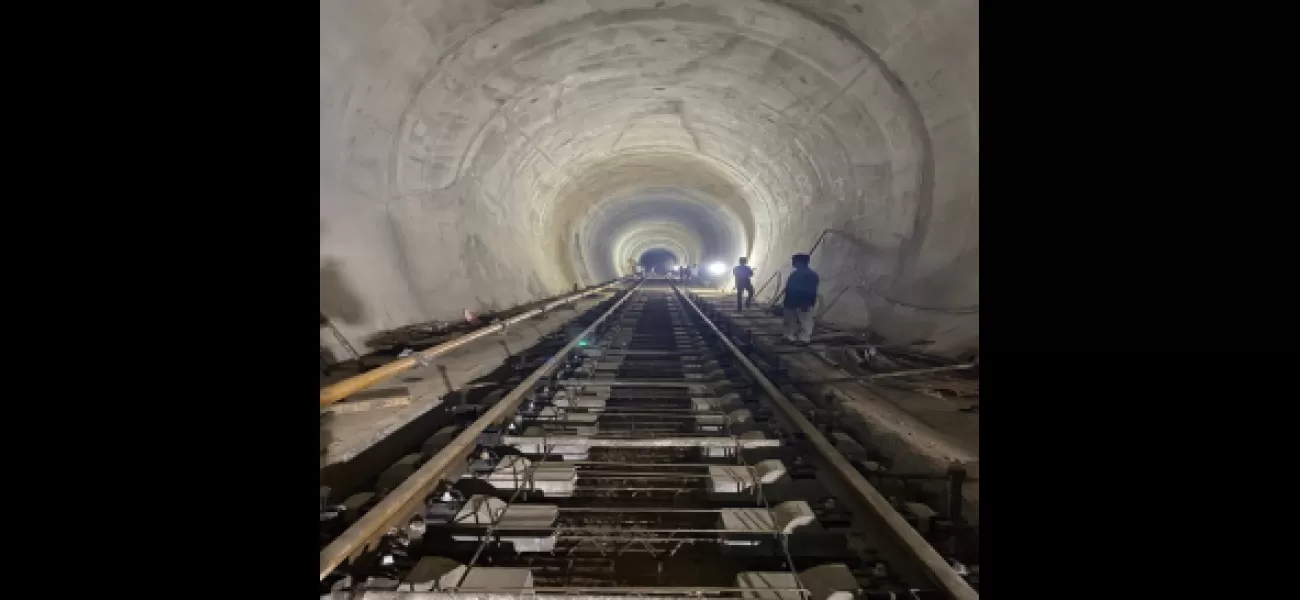ECoR is implementing ballastless track technology in its new projects.
"East Coast Railway (ECoR) is incorporating advanced ballastless track technology in railway tunnels to improve safety, efficiency, and sustainability in their projects."
August 14th 2024.

Bhubaneswar: According to official sources, the East Coast Railway (ECoR) is making significant advancements in the safety, efficiency, and sustainability of rail transport. This is being done through the adoption of advanced ballastless track technology in railway tunnels during the construction of new projects within its jurisdiction. This revolutionary move is set to change the game for rail transportation in the region.
The ECoR first implemented the Rheda 2000 Block System for Tunnel No.1 between Baliguda and Kakiriguma stations as part of the Koraput-Singapur Road doubling project. This has proven to be a successful venture, leading to the decision to use this system in all under-construction tunnels of ongoing projects as well. Plans are also underway to replace existing tracks in tunnels with ballastless tracks. For instance, the Kothavalasa-Kirandul and Koraput-Rayagada doubling projects, as well as the Khurda Road-Bolangir and Talcher-Bimlagarh new line projects, are all currently in progress and will incorporate ballastless tracks.
The implementation of ballastless tracks, especially in tunnels, offers several key benefits that cannot be overlooked. The first and most significant advantage is that these tracks are more durable and require less maintenance compared to traditional tracks. With the absence of ballast, common issues such as ballast degradation and shifting, which can cause track misalignment, are eliminated. Additionally, the materials used in ballastless tracks, such as concrete and steel, provide a longer service life, making them a more sustainable option for tunnels. The rigidity of the track structure, without the presence of ballast, ensures consistent alignment and reduces the risk of derailment, making it a safer option for trains passing through tunnels. This factor is especially crucial in tunnel environments where space is limited and any misalignment can lead to serious consequences. Furthermore, the ballastless tracks are designed to handle higher loads, making them suitable for high-speed rail or heavy freight traffic that may pass through tunnels.
Another significant benefit of ballastless tracks, particularly in tunnels, is that they require less frequent maintenance due to their robust design and construction. This is particularly beneficial in tunnels, where access to maintenance work is often more challenging and costly. With ballastless tracks, the need for frequent maintenance is reduced, leading to cost savings and increased efficiency in the long run.
In conclusion, the East Coast Railway has taken a monumental step towards revolutionizing rail transport in the region by adopting advanced ballastless track technology in railway tunnels. This move will not only improve the safety, efficiency, and sustainability of rail transport but also lead to cost savings and increased productivity. With the implementation of ballastless tracks, the ECoR is setting a new standard for rail transport in the country.
The ECoR first implemented the Rheda 2000 Block System for Tunnel No.1 between Baliguda and Kakiriguma stations as part of the Koraput-Singapur Road doubling project. This has proven to be a successful venture, leading to the decision to use this system in all under-construction tunnels of ongoing projects as well. Plans are also underway to replace existing tracks in tunnels with ballastless tracks. For instance, the Kothavalasa-Kirandul and Koraput-Rayagada doubling projects, as well as the Khurda Road-Bolangir and Talcher-Bimlagarh new line projects, are all currently in progress and will incorporate ballastless tracks.
The implementation of ballastless tracks, especially in tunnels, offers several key benefits that cannot be overlooked. The first and most significant advantage is that these tracks are more durable and require less maintenance compared to traditional tracks. With the absence of ballast, common issues such as ballast degradation and shifting, which can cause track misalignment, are eliminated. Additionally, the materials used in ballastless tracks, such as concrete and steel, provide a longer service life, making them a more sustainable option for tunnels. The rigidity of the track structure, without the presence of ballast, ensures consistent alignment and reduces the risk of derailment, making it a safer option for trains passing through tunnels. This factor is especially crucial in tunnel environments where space is limited and any misalignment can lead to serious consequences. Furthermore, the ballastless tracks are designed to handle higher loads, making them suitable for high-speed rail or heavy freight traffic that may pass through tunnels.
Another significant benefit of ballastless tracks, particularly in tunnels, is that they require less frequent maintenance due to their robust design and construction. This is particularly beneficial in tunnels, where access to maintenance work is often more challenging and costly. With ballastless tracks, the need for frequent maintenance is reduced, leading to cost savings and increased efficiency in the long run.
In conclusion, the East Coast Railway has taken a monumental step towards revolutionizing rail transport in the region by adopting advanced ballastless track technology in railway tunnels. This move will not only improve the safety, efficiency, and sustainability of rail transport but also lead to cost savings and increased productivity. With the implementation of ballastless tracks, the ECoR is setting a new standard for rail transport in the country.
[This article has been trending online recently and has been generated with AI. Your feed is customized.]
[Generative AI is experimental.]
0
0
Submit Comment





